| Photojournal
- 28 May
2005
Making
a pig of myself
|
On Saturday morning
I headed out to Colony Farm Park to see if I could get some decent
photos of a Lazuli Bunting. The latest reports, from some very
reliable fellows named Dave and Larry, had placed some of these
blue beauties in the park near the former pig barns. I had gotten
some clarification from Larry about exactly where that was, and
I prepared myself for ear identification by listening to the song
of the Lazuli (on a birdsong CD that I have) over and over, on
the way over.
I parked at the park
at about 9:15 and started walking down the path by the train tracks.
My first encounter was with a butterfly—a Painted Lady, to
be exact. I saw very few birds on my walk down the path, except
for a group of about eight European Starlings that I seemed to
push along. There was a train of rail carriers (railroad cars
that carry rail sections) on the tracks behind the businesses
that are just off of United Boulevard. Here's a shot looking back
at them from later in the day.
|
|
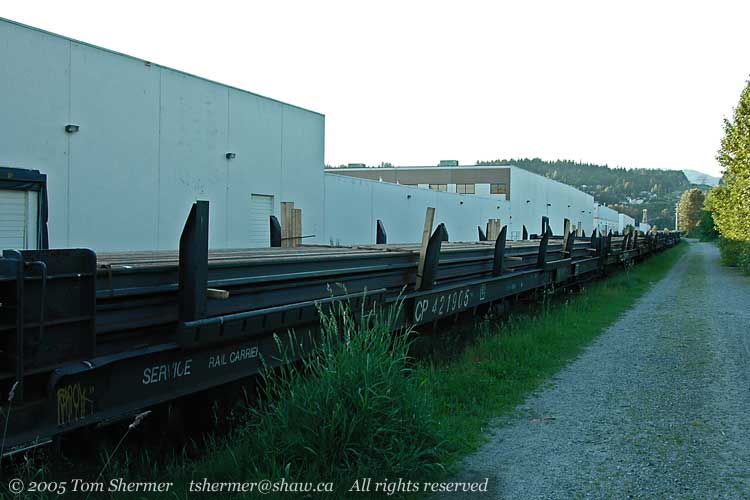 |
|
At this point, I spotted
a roughly-sparrow-sized bird flying from a tree near the tracks
to one over by the warehouses. It seemed greyish in flight and
I thought that it was a song sparrow or robin. I finally got my
bins (binoculars) on it and was quite surprised to find it was
a Lazuli! The blue hadn't shown at all during its flight. I started
across the tracks towards the tree, but then lost the bird in
the foliage and after about five or ten minutes gave up on it.
While I was over there,
though, I noticed a pretty funky sight on one of the trailers
parked next to a warehouse. The paint used for the logo on the
side of the trailer was peeling; it wasn't flaking off but rather
rolling up.
|
|
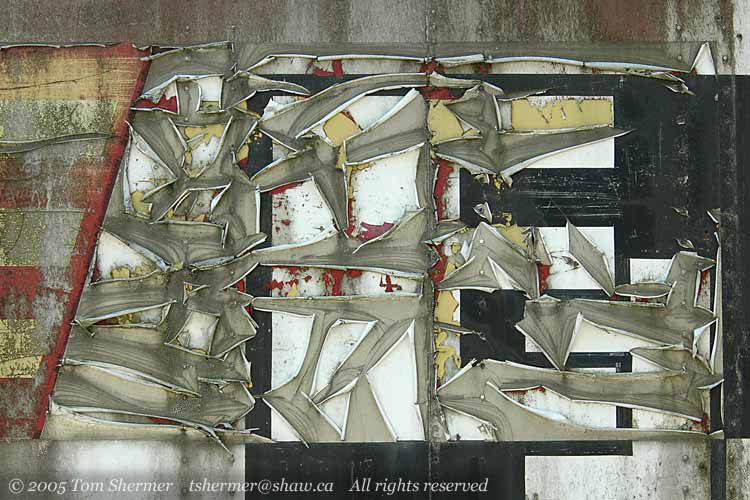 |
|
After taking a few
shots of that, I went back to the park side of the tracks. I was
encouraged by the easy encounter with the bunting and hoped that
it wouldn't be my last of the day.
I watched the tree
that the Lazuli had flown from for a while, and found a
little guy hopping around. He's a young White-crowned Sparrow
in funny light.
|
|
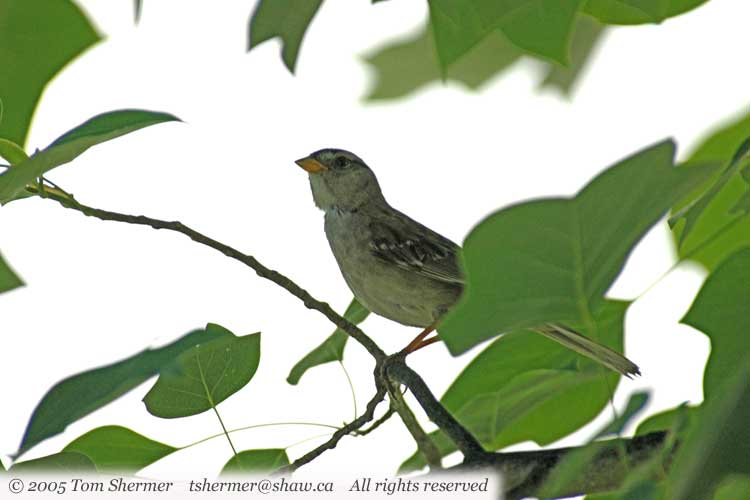 |
|
Turning to wander further
along, I saw a pair of pigeons on the rails up ahead of me. I
immediately noticed the little white crescent on the back of their
neck and pulled up the camera and shot. Regular pigeons (a.k.a.
Rock Doves) don't have that crescent; the bird that we get here
that does have it is the Band-tailed Pigeon. The birds flew off
before I could get close enough for a really good shot, but I
got a few where they are at least identifiiable.
In this shot, you can't
see the crescent on the nape, but the yellow feet are fairly obvious.
|
|
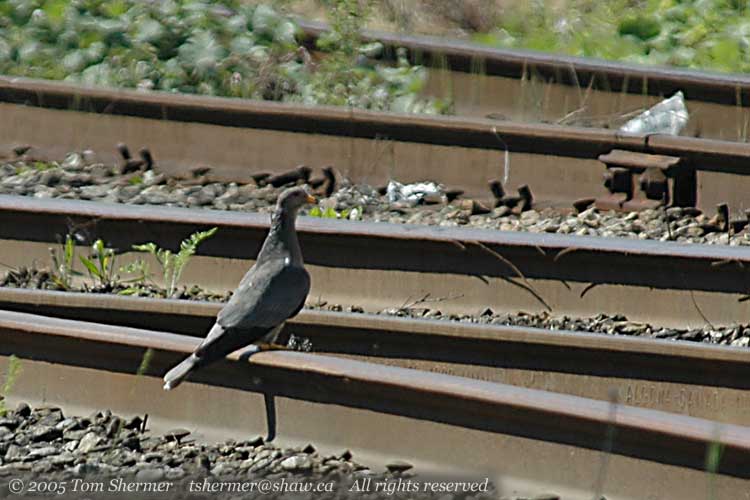 |
|
Rock Doves, of course,
have red feet.
Colony Farm Park is
next to a place with the intriguing title of Forensic Psychiatric
Institute. It looks much like a prison from the outside, and
no, I haven't visited the inside. At least, not since a few months
ago when they told me I could go free.
The importance of this
is that the pig barns are located near the place where the road
by the railroad tracks meets the road leading west from The Institute.
And I was at this intersection. I didn't see the pig barns right
away, but I did notice Mrs. Wood in the water in the ditch. She
seemed to have her figurative hands full, looking after 17 youngsters.
|
|
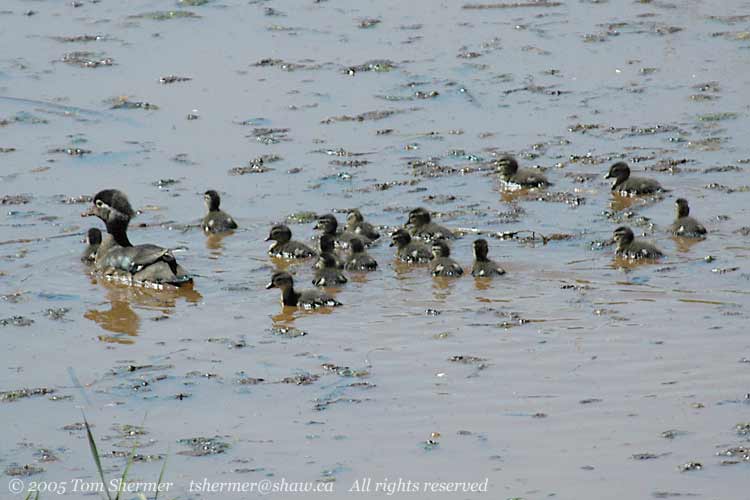 |
|
Mrs. Wood, naturally,
is a Wood Duck.
I started down the
road towards the institution, and immediately saw a bird land
in a tree to my right. It was a House Finch, and I liked the way
it looked like she had tousled hair flapping in the breeze. It
reminded me of some of my colleagues—we're a notably disheveled
bunch.
|
|
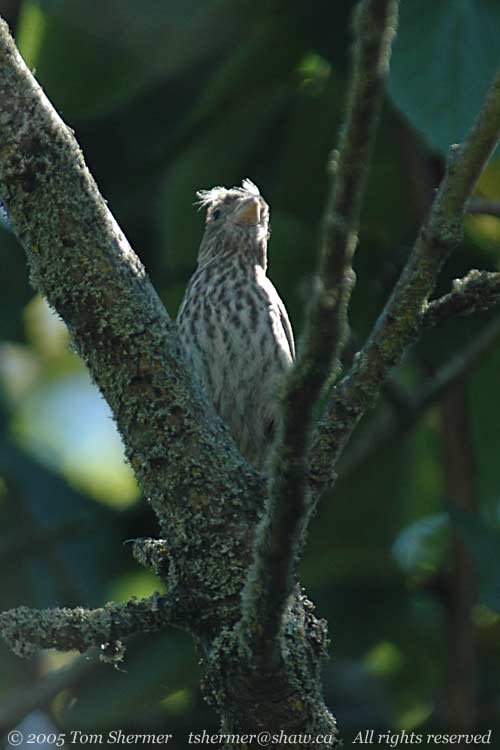 |
| I walked
just a little ways further, maybe 10 meters, and stopped when I
heard, mixed in with the car noises from afar, something that reminded
me a little of what I had been listening to from my birdsong CD.
The ruins of the pig barns were on my left, and there was a tree
on my right. I looked through that tree, and eventually my eyes
settled on the guy below. He was one of those Lazuli Buntings I
was looking for. I started snapping photos, but the bunting was
in the shade and only offered up head shots before flying away. |
|
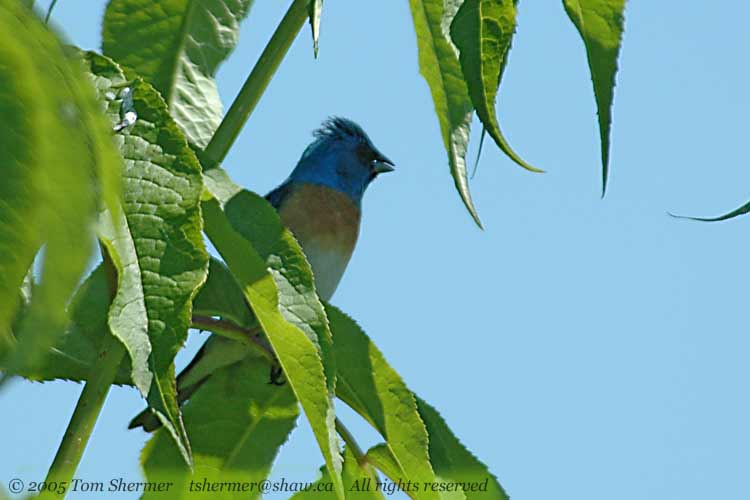 |
| A House
Finch, this one a male, was jumping around in the tree after the
Lazuli left. I tired of watching him, and finding nothing else there,
I continued on. About twenty meters further, on the left side of
the path, and a bit back from it, there was a large tree. I scanned
it and found another Lazuli out on a tuft of foliage. I took a few
photos, even though he was quite far away. |
|
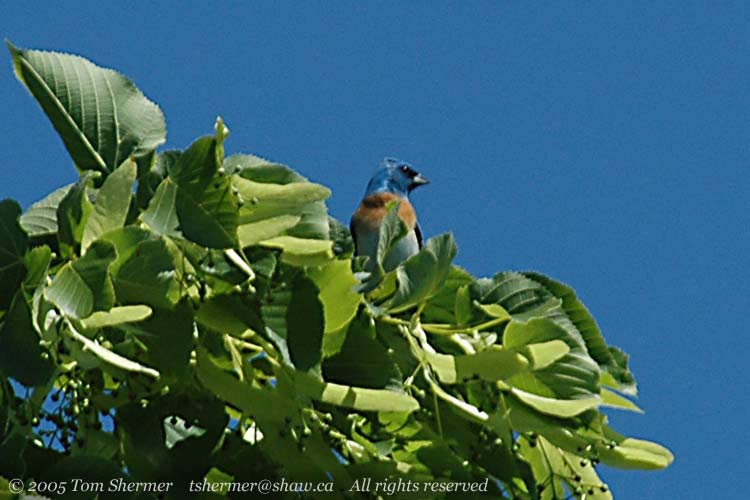 |
|
As I watched, he flew
down to the grass beside the path another 15 meters in front of
me. I moved along, trying to get closer, and to get a clear camera
angle on him, without flushing him. I didn't manage that, and
I ended up focussed on the grass in front of the bird and not
the bird himself.
After he flew off,
I headed back to the tree on the right of the path, and found
another Lazuli who quickly flew. There were also a trio of Cedar
Waxwings there. I took some photos of them; despite bad lighting
conditions (they were in the shade with a bright sky behind them).
I did a little Photoshop work to try to salvage a photo that I
liked. I like this one because of the dashing way he's holding
the feathers of his crown.
|
|
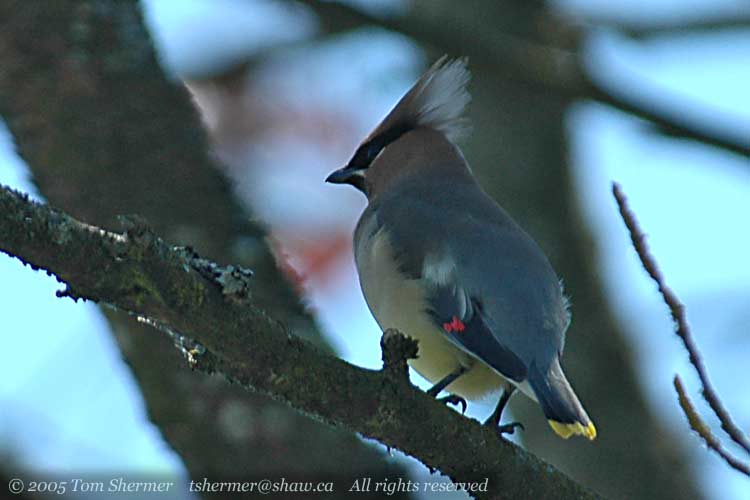 |
|
Cedar Waxwings are
very common around here, but they're quite pretty.
Looking up, I noticed
a Red-tailed Hawk circling. It was joined by another, and they
ended up coming a bit down in the sky and closer to me. I took
the opportunity and shot a lot of almost-vertical shots, not knowing
how they would come out, as it was nearing noon and that put the
sun almost directly over them. Some of them came out okay, though.
|
|
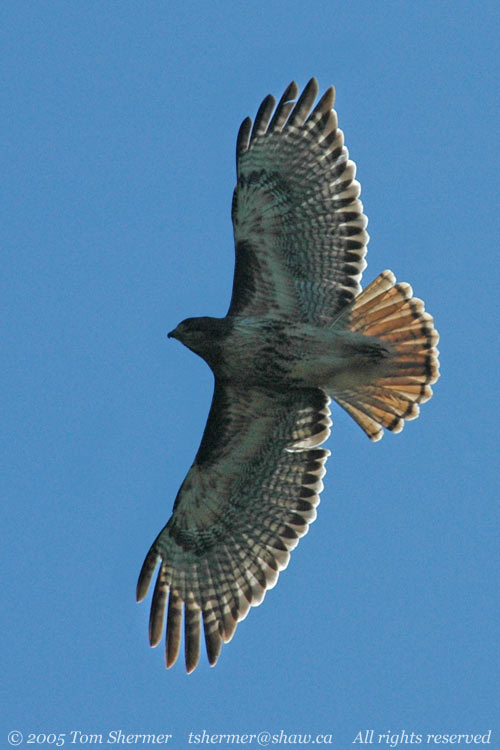 |
|
More light on that
hawk's head would've made that shot very nice.
I decided to step down
into the ruins of the pig barn itself, to see if any of the trees
near it held any Lazulis. I did find another one, but the strong
noontime sun made the lighting on him pretty awful for photographs.
That sun was beginning to take its toll on me, too, and as I was
hungry, I decided to pack it in and head to lunch.
I had my customary
lunch at the Golden Pita, but of my usual lunching buddies, only
Matthew was there. I haven't mentioned it, but I had my car broken
into a few weeks before. At first I had thought that I hadn't
lost anything in the break-in, but I eventually noticed that I
couldn't find the 18-70mm lens that had come with my camera. I
had vaguely formulated a plan to replace the lens, and discussed
that with Matthew, who encouraged me to act on my plan. Clearly,
he's a good friend.
So after lunch, Matthew
and I headed to Coquitlam Centre, where there's a fine camera
shop, and I bought a new general-purpose lens. It's a 24-120mm
lens, so it won't quite take a wide-angle photo as wide as my
old lens would, but it has less distortion overall and also has
vibration reduction, which makes it easier to hand-hold. (I also
have this feature on my long telephoto lens, which I use for taking
the bird shots.)
So when I got home,
I headed outside to try out my new lens. I first went across the
street to the rail yard, where I got a few shots of graffiti on
boxcars.
|
|
 |
|
That's a much wider-angle
shot than I could have done the day before. I could probably have
gotten a similar shot with my long lens, but I would have to be
much farther away, and worry about intervening street signs and
fences and such. It was much more convenient to walk up near the
car and snap the photo.
Here's the other end
of the same car.
|
|
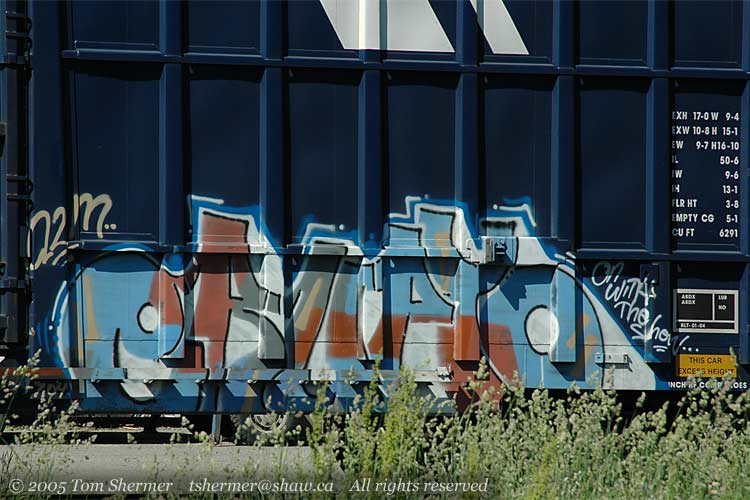 |
| I then took
a few shots of the building that they're constructing on the corner
between my building and Quayside drive. Here's a nice one, with
converging vertical lines...the telephoto would never have gotten
me this. |
|
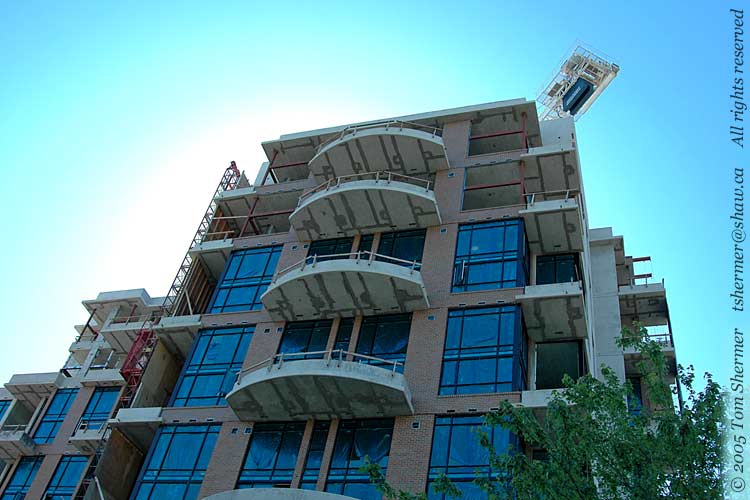 |
| I also tried
out the lens in the courtyard to my building, doing some smaller
subjects, like my friend Puss-in-boots, here. Puss is a pretty shy
kitty, and I don't see her too often. |
|
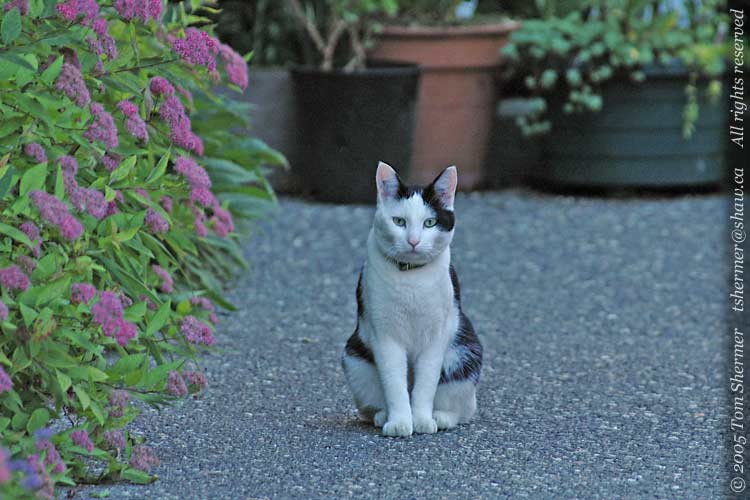 |
|
When I got inside,
I examined my day's photos. I was quite happy with the shots from
the new lens, especially the wide-angle ones, but I found that
I didn't get any shots of the Lazuli Buntings that were as good
as what I was really hoping for. So I decided to head back to
the park a little later on, thinking that the evening sun would
provide better lighting.
So around 5:15 I arrive
again, this time parking by the warehouses off United Boulevard
and walking through one of their parking lots (by the peeling-paint
trailer) to the path by the rails. I checked the tree on the left
of the path, and noticed a bunch of American Goldfinches flitting
around in it. As I started to take photos of one of the male Goldfinches,
he got chased off the branch by this fellow.
|
|
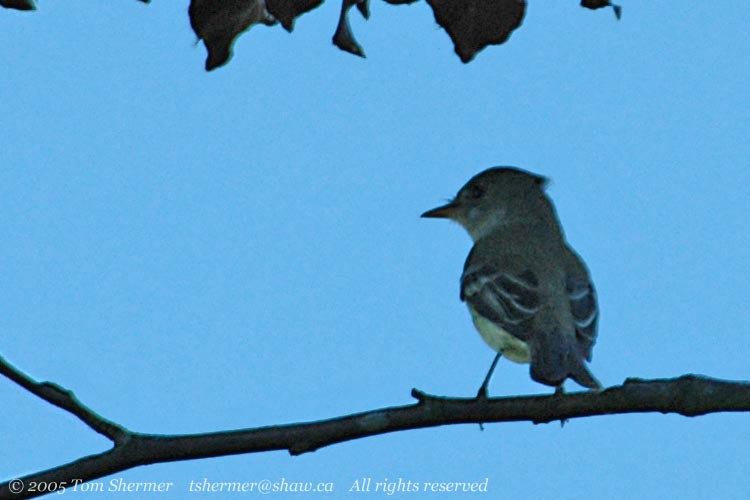 |
|
He's a little dark
and blurry, but my friends who know a little about birds assure
me that he's probably a Willow Flycatcher.
After the flycatcher
flew off, I turned my attention back to the goldfinch, who had
settled on a lower branch. As soon as I started shooting him,
he flew off, too.
|
|
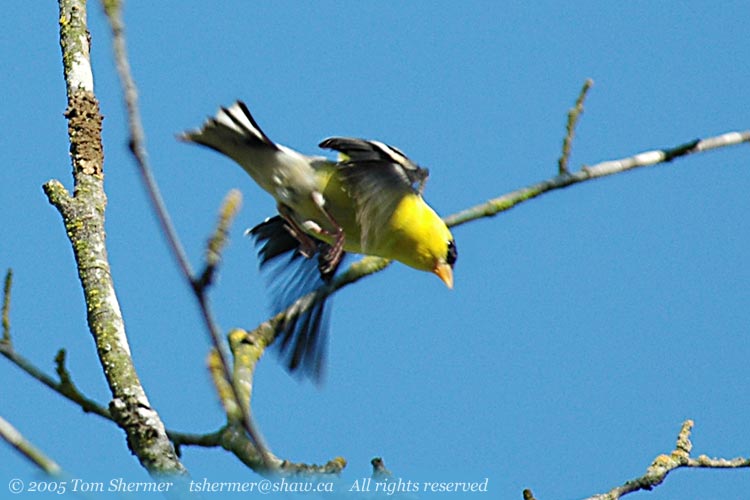 |
| In another
minute or two, though, a Lazuli flew in, and I finally caught a
few shots of one of some in decent light. |
|
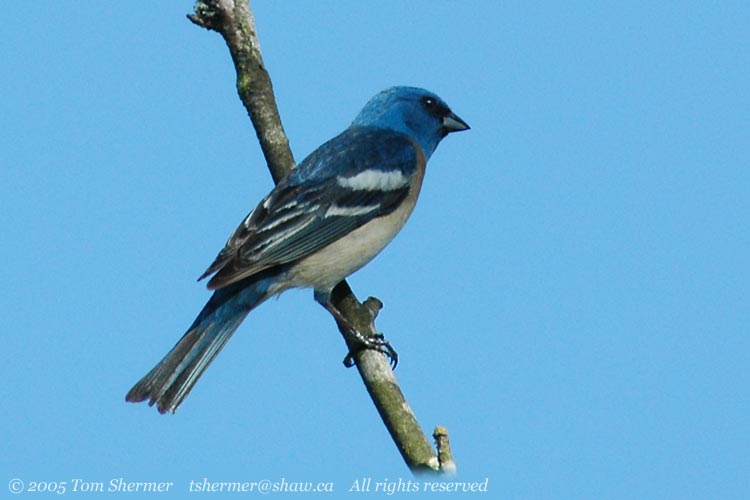 |
|
But he didn't turn
his rufous breast towards me, and I wanted a good shot of that,
too. So I decided to go down into the ruins of the pig barns and
see if any more Lazulis would show up.
I turned and faced
the ruins, and saw a Milbert's Tortoiseshell perched on one of
the rocks in front of me. He was kind enough to sun himself whilst
I took a portrait of him.
|
|
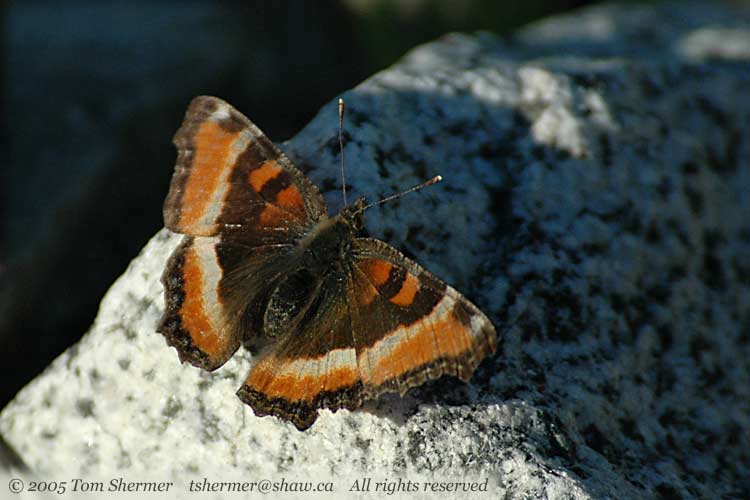 |
|
Here's what the ruins
of the pig barns look like. Those concrete walls aren't even waist-high
on me; I guess when you're as vertically-challenged as a pig is,
you don't need very high walls to get a sense of privacy.
|
|
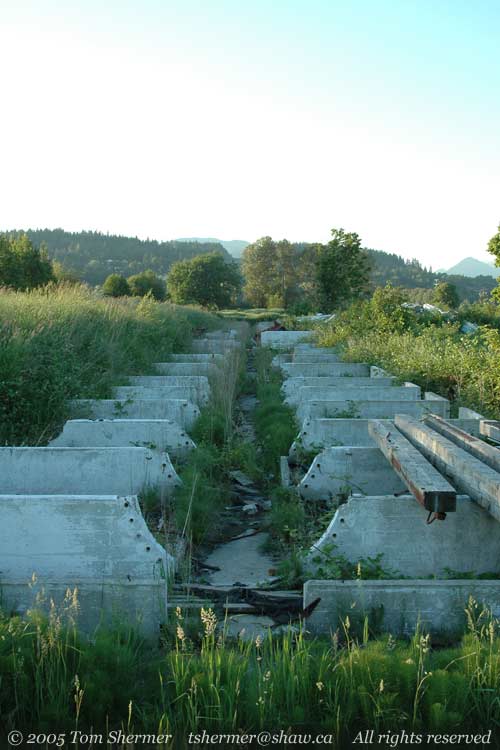 |
|
I climbed down to the
ruins and the Tortoiseshell fluttered off.
About two-thirds of
the way down, on the right, there is a relatively tall pair of
trees; they're the ones just poking above the background hill
in the above photo. I thought I would go watch these trees, as
they had seemed quite popular with the birds that morning.
Actually, the two trees
seemed rather interesting in and of themselves. Their trunks grew
about a half of a meter apart, and the left half of each tree
was bare, and the right half had foliage. It was an odd sight.
|
|
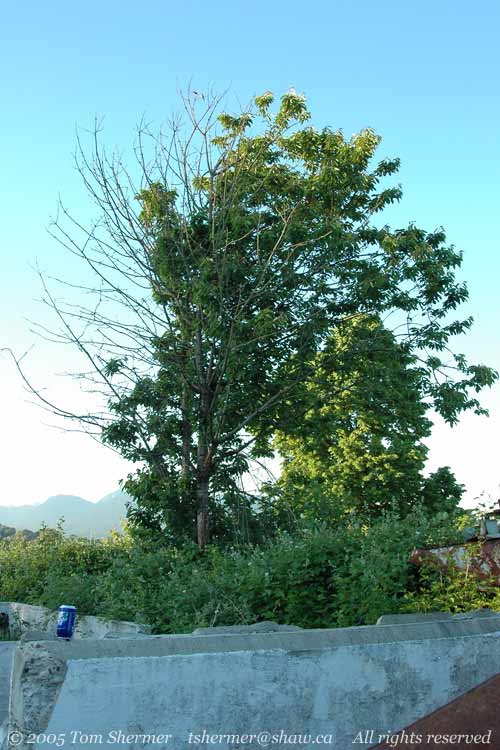 |
|
Anyhow, some birds
would stop on the bare limbs (making for easy photos) and others
would stop on the foliage, and then sometimes hop over to the
bare side.
(And no, that's not
my beer can—not my brand.)
I chose a block of
cement near the two half-trees and sat on it, taking off my knapsack
and making myself at home. I know that there are those who would
say that it's not really a stretch for me to feel at home in a
pig barn, but those are people who've never really truly appreciated
the finer points of my lifestyle.
Anyway, it was good
for me to sit; it helped the birds feel more comfortable with
hanging out in the trees.
And hang out they did.
Most of the time I was there, there were two or three American
Goldfinches in the tree: different ones; they were always coming
and going. A female House Finch caught my eye; she was greyer
(less brown) than many of the ones I had seen on the day.
|
|
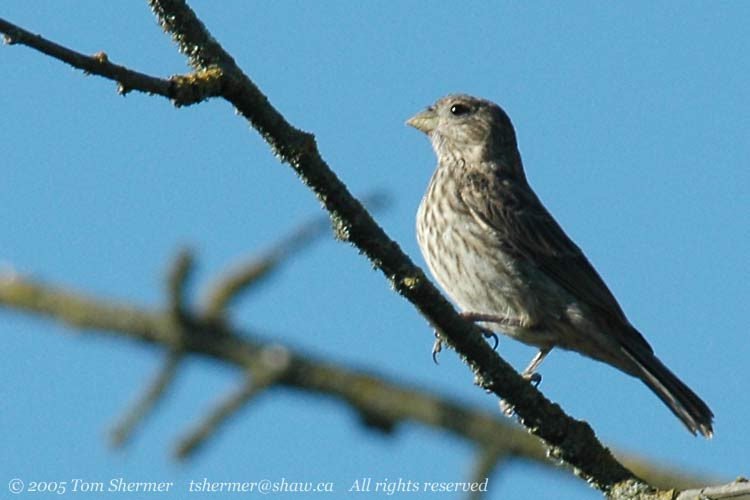 |
| I stood
to get closer to that grey female, and I caught sight of a yellowish
finch through the branches. The guy from a few days ago was questionable,
but this one was undoubtedly a yellow-morph House Finch. |
|
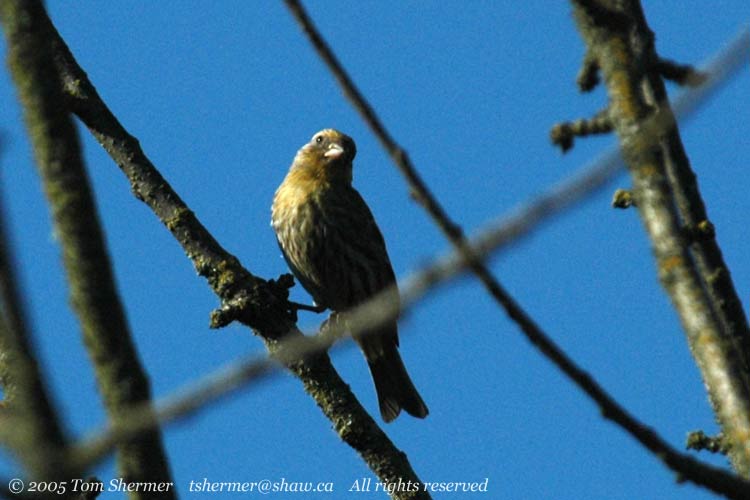 |
| After I
sat back down, a Lazuli came by. I got up and crept a bit closer
again. This guy was kind enough to face me, so I got a decent shot
showing the rufous breast and white belly. (After he finally
turned his head so that I could catch a highlight from the sun in
his eye.) |
|
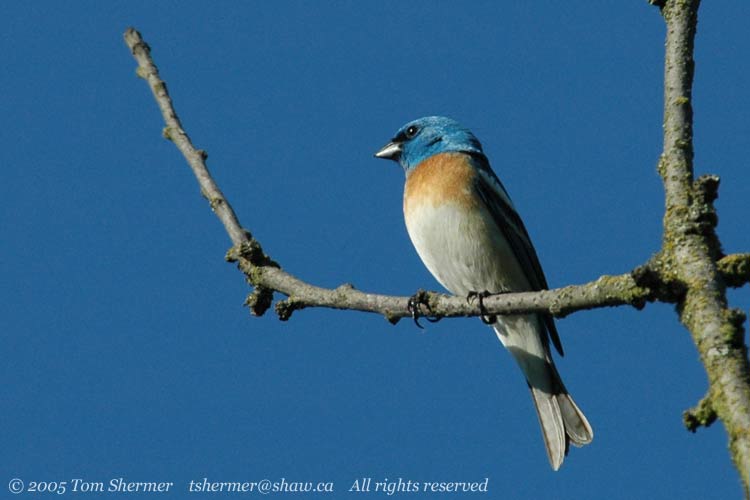 |
| I next concentrated
on the goldfinches, and got some of my best shots of them from the
day. Here's a female. |
|
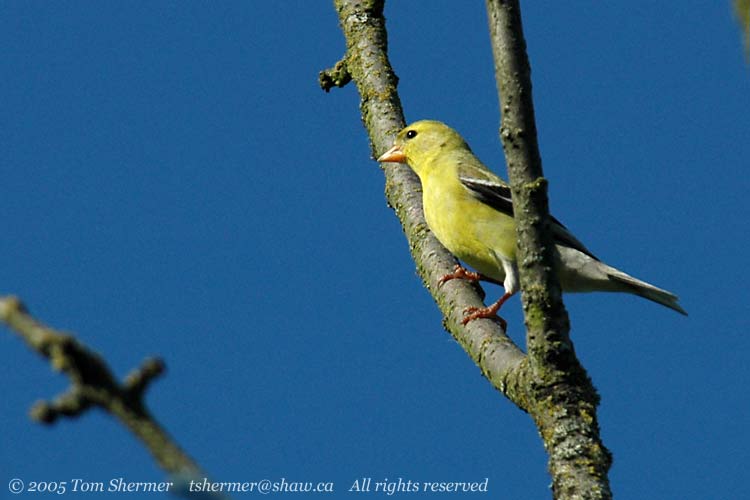 |
| And here's
a male, creeping along a branch. |
|
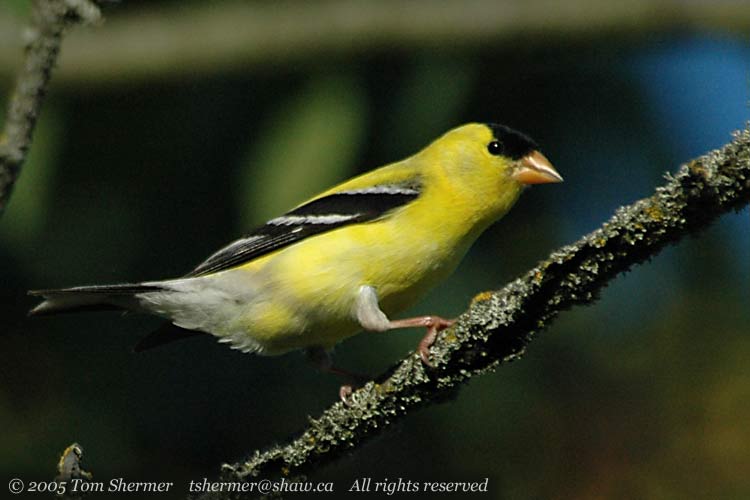 |
|
When I finished with
the Goldfinches, I looked to my left and found that my yellow
House Finch had returned. This time I was closer and got better
photos.
|
|
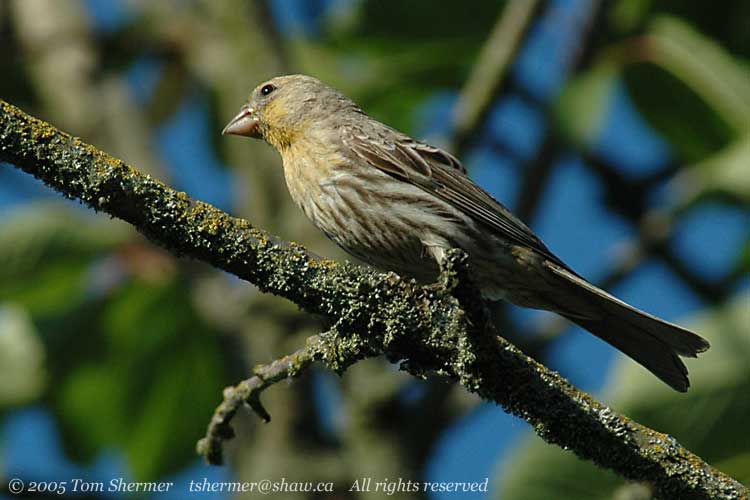 |
|
Throughout my time
in the pig barns, there had been fifteen or twenty swallows flying
around the area. Sometimes they all came in low, flying a meter
or two above the ground of the ruins. I watched three of them
chasing one another around...it looked as though they were enjoying
that, as they kept at each other for at least five minutes straight,
or maybe longer. Occasionally one or more swallows would settle
in the two trees or on the ruins, so I decided to try to get photos
of them when they stopped. (I would have tried for some flight
photos as well, but swallows are awful quick and I still wasn't
supposed to twist my torso too much.) Anyhow, one of the first
to stop was this Violet-green Swallow, who was puffed up like
a fluffball.
|
|
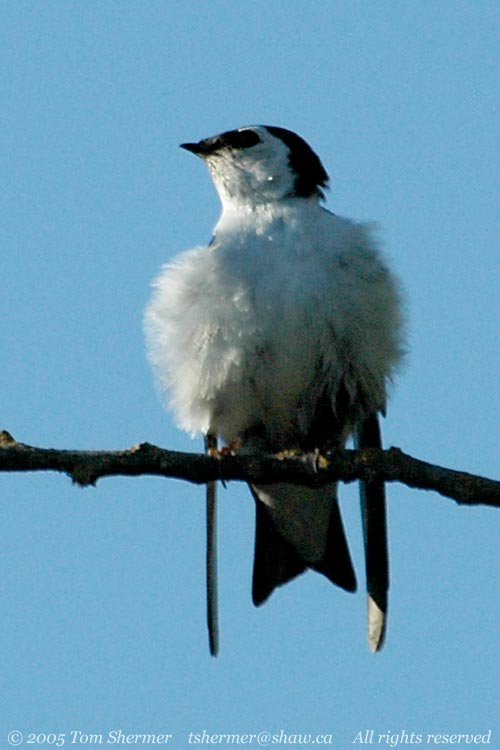 |
|
As I took pictures
of it, it gradually shrank back to normal swallow shape. I next
caught a Violet-green resting on a rusty piece of somethin', showing
some of his gorgeous colors.
|
|
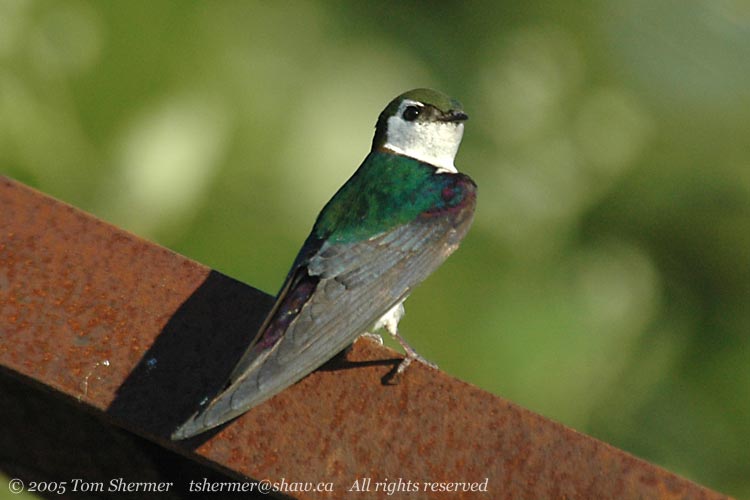 |
|
There were some Barn
Swallows around, too. Here's two shots of one of those svelte
little guys.
|
|
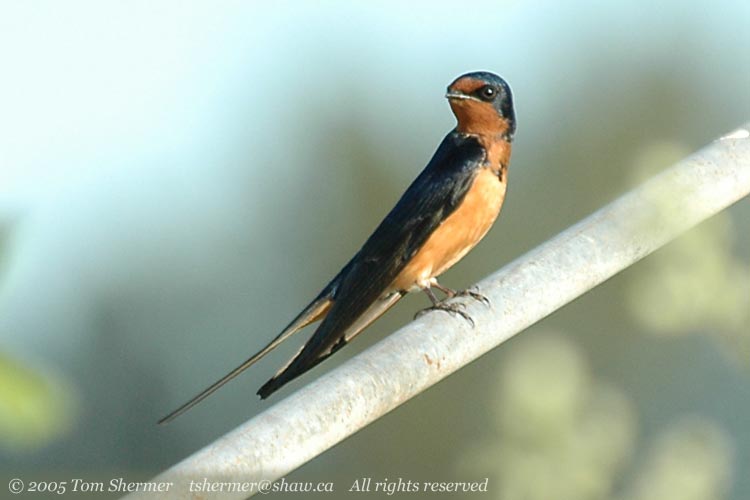 |
| |
|
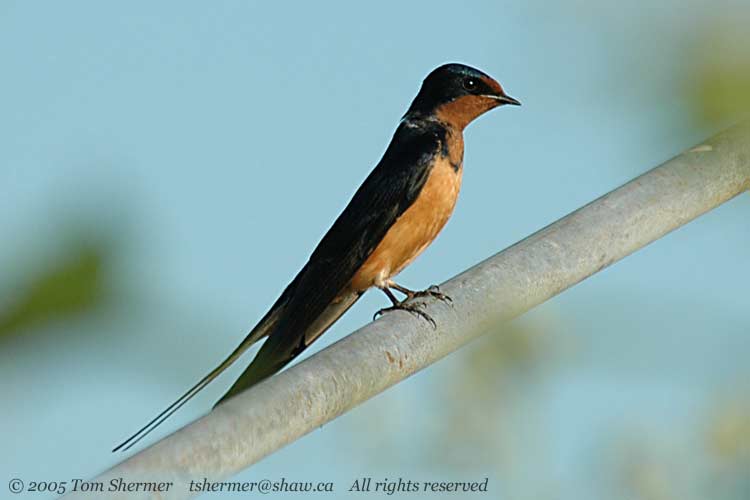 |
|
Then I found the following
swallow on one of the trees. This is a Violet-green Swallow, either
a juvenile or a drab-morph bird. One of my other photos of him
shows that the top of his head was olive-colored, like the one
three photos ago.
But in the field, I
wasn't really able to identify him. I thought that he was maybe
a Northern Rough-winged Swallow.
|
|
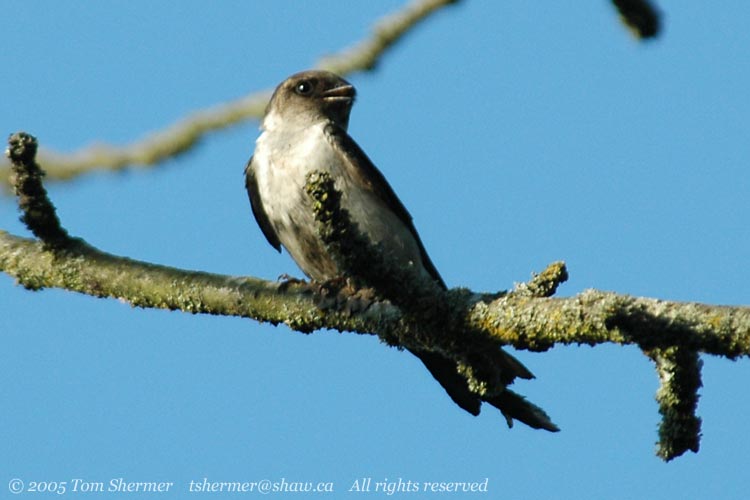 |
|
And that swallow actually
gave me quite a hard time about that. He had a blast laughing
at me not being able to identify him. When I tried to get closer
and stumbled a bit, he even suggested I was drunk, and asked me
to touch the tip of my nose with my finger, illustrating the procedure
for me. "Like this," he mocked.
|
|
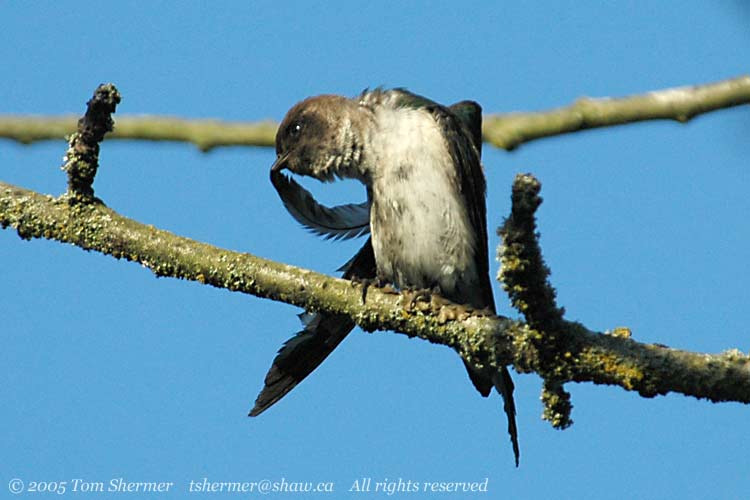 |
|
I had told him like
I told you...it wasn't my beer can. Not that he would believe
it...he sure was a nervy little guy. Imagine that...a swallow
making fun of me like that! How low I must have sunk...
Well, after that embarrassing
moment, another Lazuli came by and gave me a modelling session,
but the photos were mainly like the last Lazuli I showed above.
I happened to notice a Cedar Waxwing up in the tree, and then
saw two more arrive. Here's one of the latecomers; the lighting
is much better on this one than the one from the morning.
|
|
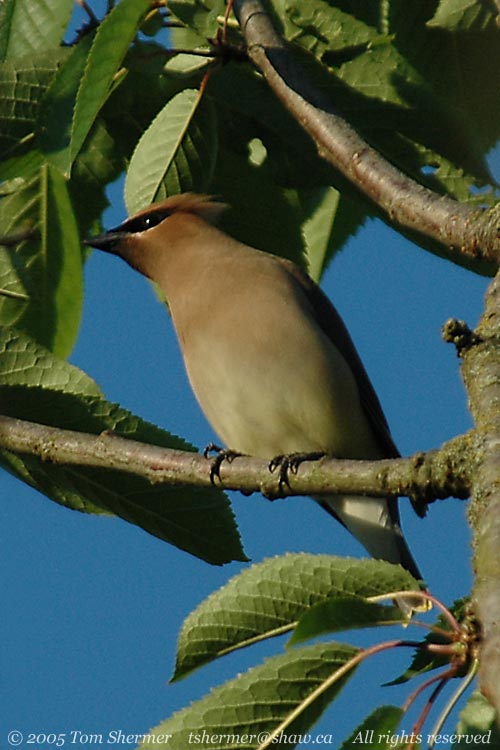 |
|
It was getting late
and the sun was fleeing the scene. I put my knapsack back on my
back, and as I was bidding my little stall adieu, I had
one final visitor show up.
|
|
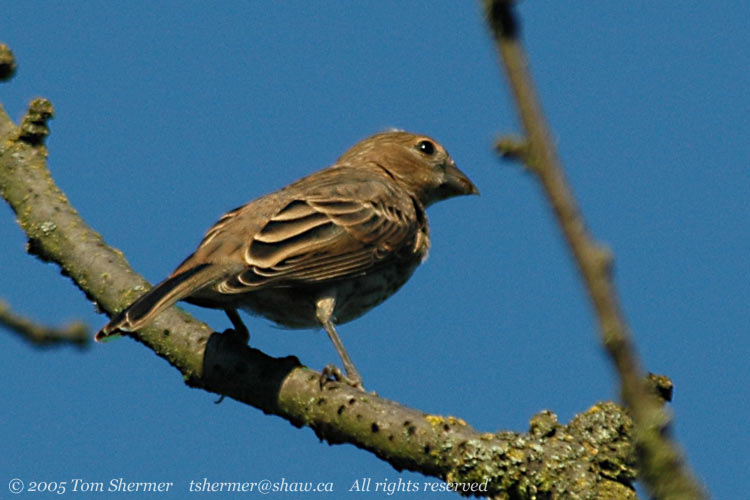 |
|
That lady is a Brown-headed
Cowbird. But don't let her beauty fool you...she's a sneaky one.
Lady cowbirds don't construct their own nests, but rather lay
their eggs in the nests of some other species, leaving the tasks
of egg incubation and raising of the young to others. (This is
called brood parasitism.) Brown-headed Cowbirds have been
recorded laying eggs in the nests of over 200 other species...so
just about anybody they can sneak an egg in on, they will. Incorrigible!
Anyhow, that sneaky
lady ended my long and fairly successful day in the field.
Never laying eggs in
anybody's nest,
Tom
|
|
|